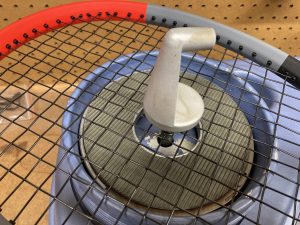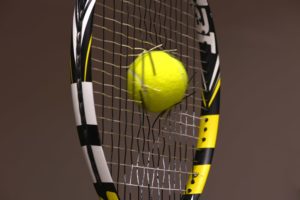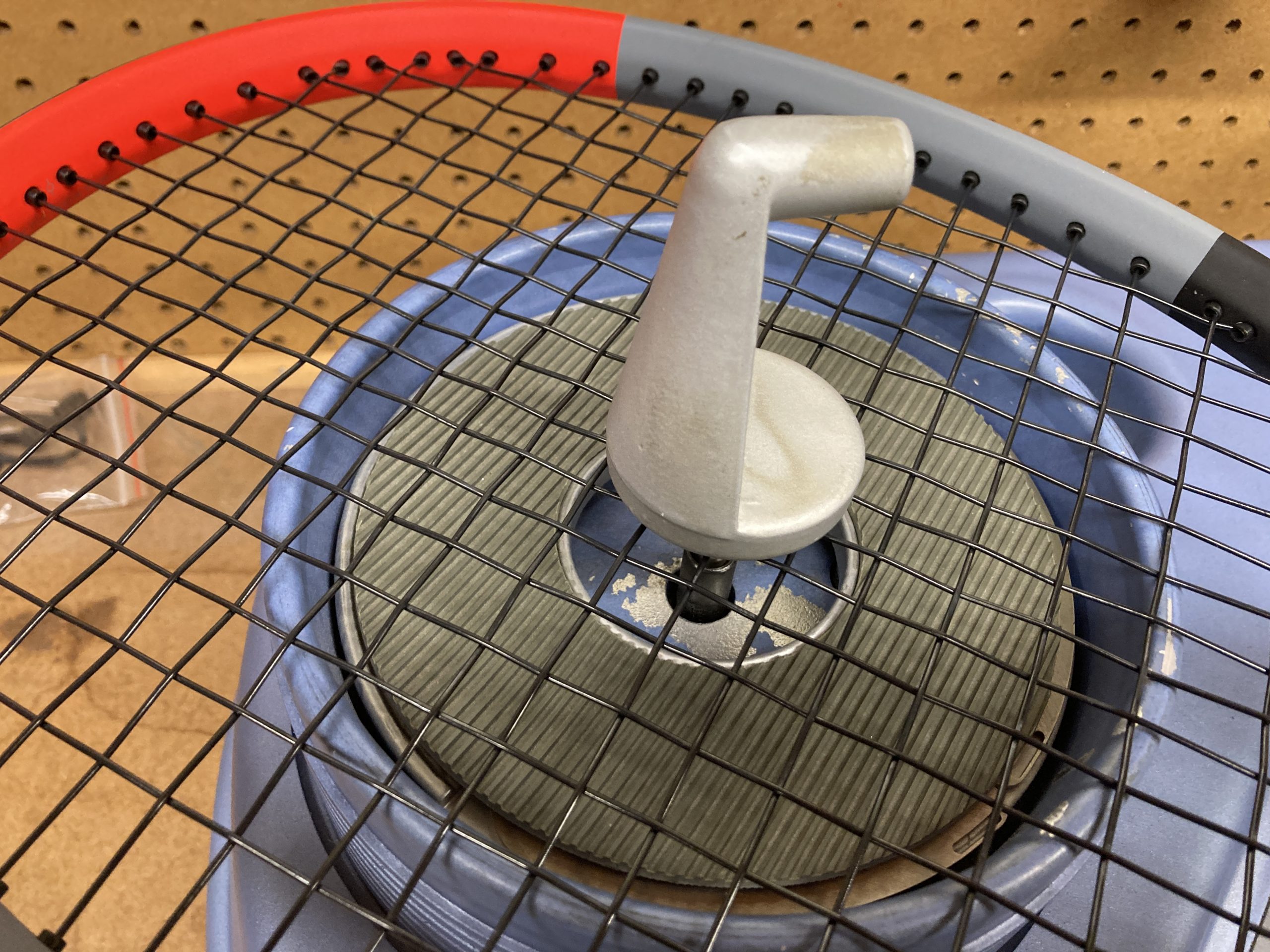Tight vs Loose – What’s Best for Me
 The age-old question for tennis players has always revolved around string tension and how it affects your game. Figuring out what tension is optimum for your racquet has to start with understanding the physics of string. It’s not just the tension or the string used. It’s much more than that. Some of us remember when all head sizes on tennis racquets were the same and the stringing patterns of those racquets didn’t vary much at all. In those days, choosing a reference tension was about all you had to worry about but that’s all changed. As the game has evolved, so have racquet and string technologies. We’re no longer playing with wooden racquets that weigh upwards of 13 ounces, have an 85 square inch head size, and have a very dense stringing pattern. In today’s world, we have racquets as big as 135 square inches and as small as 90 square inches. Also, the new spin technologies in some racquets open up the stringing patterns so far you could almost drive a car through it and this has a profound effect on how the racquet feels and plays. What does this mean and most importantly, what effect do these variations play in the world of tennis today?
The age-old question for tennis players has always revolved around string tension and how it affects your game. Figuring out what tension is optimum for your racquet has to start with understanding the physics of string. It’s not just the tension or the string used. It’s much more than that. Some of us remember when all head sizes on tennis racquets were the same and the stringing patterns of those racquets didn’t vary much at all. In those days, choosing a reference tension was about all you had to worry about but that’s all changed. As the game has evolved, so have racquet and string technologies. We’re no longer playing with wooden racquets that weigh upwards of 13 ounces, have an 85 square inch head size, and have a very dense stringing pattern. In today’s world, we have racquets as big as 135 square inches and as small as 90 square inches. Also, the new spin technologies in some racquets open up the stringing patterns so far you could almost drive a car through it and this has a profound effect on how the racquet feels and plays. What does this mean and most importantly, what effect do these variations play in the world of tennis today?
Players will tend to seek one of two outcomes when it comes to tension. You will either lean towards power or control and it’s up to you and your racquet technician to find what’s best for you. The important thing to remember here is that tighter strings will have reduced power while looser strings will increase the racquet’s power. However, you must be aware that in order to completely satisfy your desires you must be willing to be patient and to provide your stringer with accurate feedback.

String Dynamics
String deforms at impact and this can be measured and recorded by using a device such as a Babolat RDC (racquet diagnostics center). The unit uses a plunger that is centered on the racquet face and then activated to apply a downward pressure directly onto the strings to return a numeric figure. That figure is often referred to as SBS (string bed stiffness) and is recorded and used as a baseline measurement, allowing the racquet technician to use a player’s feedback to make any adjustments on future restringings. If the player is satisfied, the technician will set the same reference tension on their stringing machine for the next restring provided the racquet and string combination is the same as last time. If they’re not satisfied that’s where the player’s feedback comes into play. If they desire more power then the technician will lower the reference tension on the machine and visa-versa if they desire more control.
This can be a very valuable tool when a player switches racquets but wants to use the same string. They will typically ask for the racquet to play and feel like their old racquet and the easiest way for the technician to achieve that result is to refer to the baseline measurement from the previous RDC reading. An example would be a player using a Wilson RF97 with a 16×19 stringing pattern but has decided to change to a Wilson Blade 104 with a 16×19 stringing pattern. The increased head size alone tells the technician that the reference tension is going to have to be raised to match the SBS of the previous RF97 frame. The string length of the Blade 104 is going to be longer than that of the RF97 due to the increased head size. So, in order to find a similar SBS, the reference tension on the stringing machine will have to be increased. Once the Blade 104 stringing is completed, the string bed deflection on the racquet will be measured and compared to the reading from the RF97.
 This gets us back to string plane deformation which in turn, will dictate how the racquet plays and what the player feels. When strings deform at impact, they store energy, and when they rebound they return that energy to the ball. You can do a simple test by dropping a ball from a designated height onto a hard surface and measuring the height of the bounce. Now, do the same thing using a strung racquet with your foot on the handle to stabilize it and let the ball impact the strings from the same drop height. You’ll immediately see the difference and begin to realize just why we put strings in a tennis racquet. If you were to do this with 3 racquets all strung at different tensions you now start to understand how loose strings versus tight strings will affect the power you can produce using different tensions.
This gets us back to string plane deformation which in turn, will dictate how the racquet plays and what the player feels. When strings deform at impact, they store energy, and when they rebound they return that energy to the ball. You can do a simple test by dropping a ball from a designated height onto a hard surface and measuring the height of the bounce. Now, do the same thing using a strung racquet with your foot on the handle to stabilize it and let the ball impact the strings from the same drop height. You’ll immediately see the difference and begin to realize just why we put strings in a tennis racquet. If you were to do this with 3 racquets all strung at different tensions you now start to understand how loose strings versus tight strings will affect the power you can produce using different tensions.
There is no real mystery here because, for the most part, this comes down to basics physics and working with a qualified racquet technician who has the proper equipment to meet your needs. If you’re interested in finding a technician like that you can check out our IART business listings HERE and hopefully, you can find one in your local area.


Comments (3)
Interesting article Tim and I can totally relate!
I’ve used my RDC religiously for the last 25 years and I would say it was well worth the investment!
As you mentioned, the string bed stiffness (deflection) is the bottom line in terms of what the player will ultimately feel. This “feel” is a personal preference thing, that’s why it’s important that the technician evaluate the proper reference tension to ensure the racquet provides the optimum power, control, and comfort with the player in mind.
Whether I’m stringing a different frame with a familiar string setup for the first time, or and familiar frame with a different string setup, I’ll use my best judgement to figure out the ideal reference tension to match the client’s preferred “feel” based on head size, string pattern, and string type.
However, frames and strings don’t always “behave” exactly how you expect. I’ve had situations where I had to cut out fresh strings because I felt the string bed reading was not what I expected. From there, I’ll adjust the reference tension and restring the racquet.
My Babolat RDC has proven its worth over the years, and I’ve never had any issues with it. Before the RDC was invented, there was that Flex Four machine. Remember that one?
By the way, do you know if the Babolat RDC is still being sold? I heard it’s no longer being made.
Recently I’ve had other people ask about buying an RDC but like you, I’m hearing that Babolat is no longer making them. As for the Flex 4, I’ve not only heard of it, I have one here in the shop and that’s what I used prior to the RDC. The Flex 4 has been vastly updated and is now called the Flex Infinity and you can check it out here https://flexinfinity.com.au/
Thanks for the link to the Flex Infinity. It sure has been updated from the original one.
It does looks quite interesting!
GENERAL COMMENT – Does anyone own a Flex Infinity or do you know of anyone that does? That would make an interesting article post or video review!